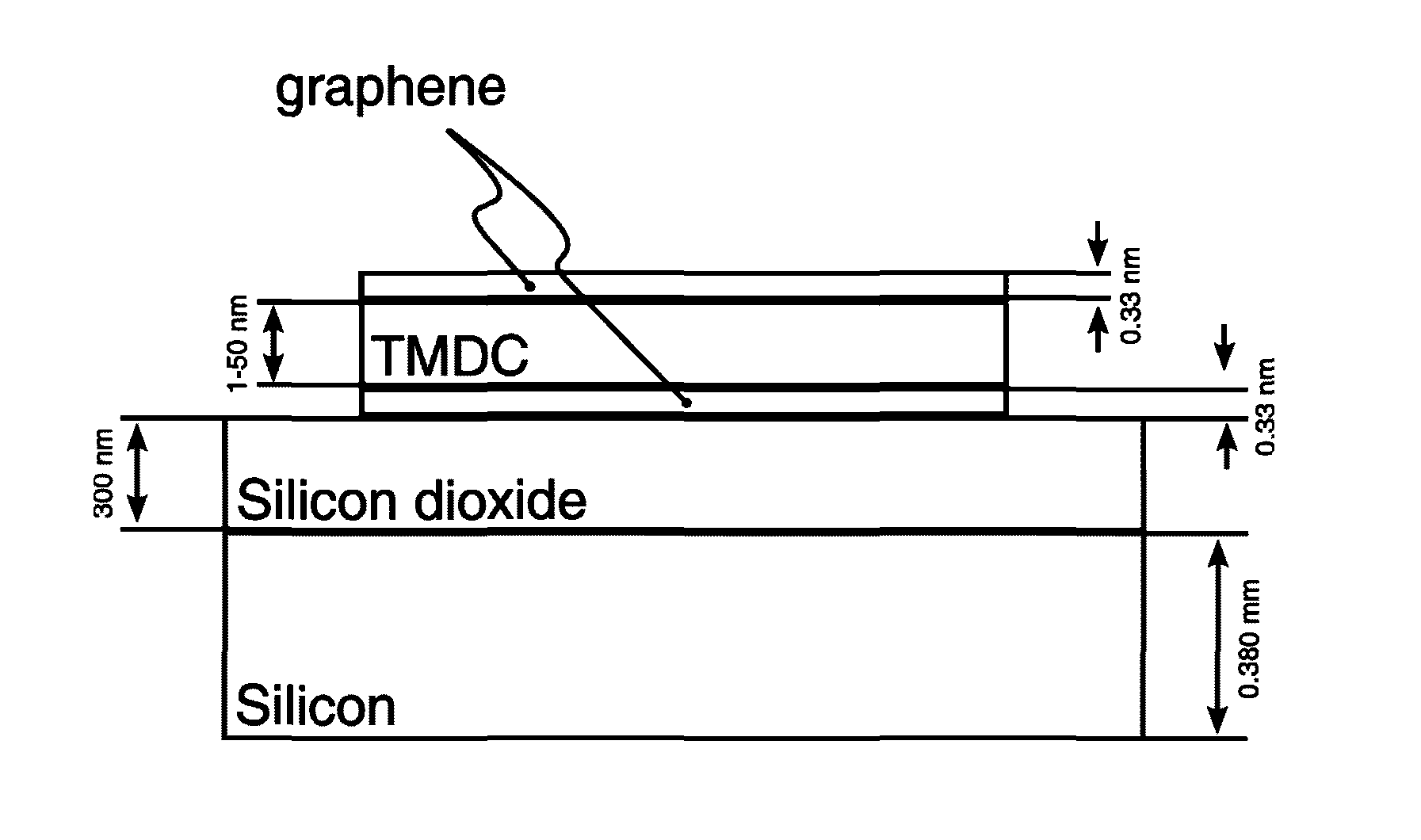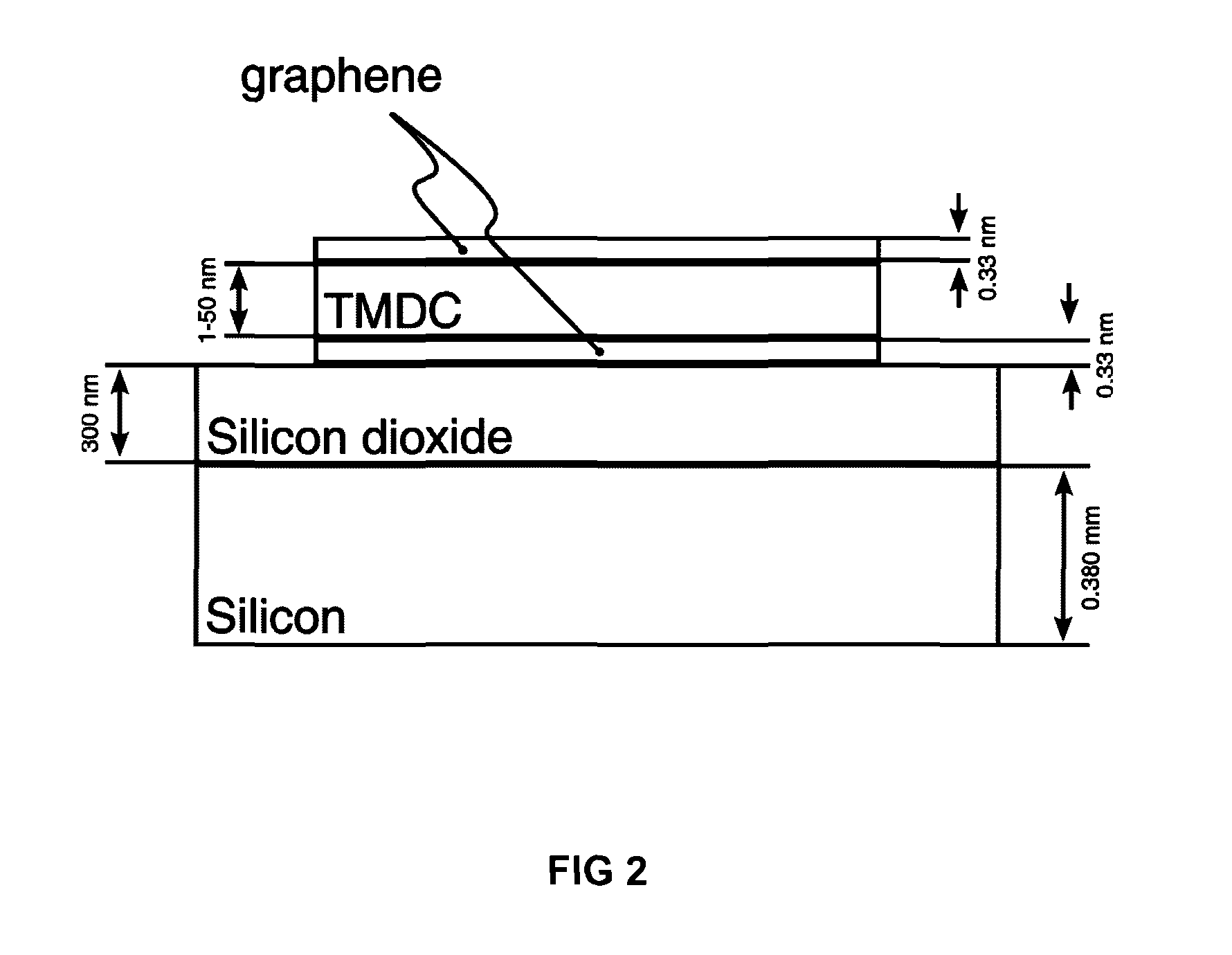Photovoltaic cells
- Summary
- Abstract
- Description
- Claims
- Application Information
AI Technical Summary
Benefits of technology
Problems solved by technology
Method used
Image
Examples
example 1
Preparation of and Photovoltaic Ability of a Graphene / WS2 / Graphene Device
[0182]The experiments described in the following sections demonstrate a beneficial combination of the properties of graphene and WS2: WS2 as a good photoactive material and graphene as a good transparent electrode. Using a graphene / WS2 / graphene stack with appropriately positioned Fermi levels and simply doping the two graphene layers differently (either by electrostatic gating or chemical methods), leads to large photocurrent. The layered nature of our structures means it is possible to fabricate large area light harvesting devices. Without illumination, such devices act as tunnelling transistors.
[0183]Devices comprising three principal layers, top and bottom graphene electrode layers (we tested both micromechanically cleaved and CVD-grown graphene) sandwiching a photoactive WS2 layer, were prepared. The left hand panel in FIG. 1 shows an optical image of a device according to the invention. In the fabrication ...
example 2
Preparation of a Device of the Invention Using Solution Processed Materials
[0212]An alternative exemplary method of preparing the devices, cells and heterostructures according to the invention is as follows.[0213]1. Metal electrodes (Cr / Au (5 / 50 nm) in our case) are patterned onto a substrate (in this case silicon / silicon dioxide).[0214]2. A WS2 film is prepared as follows.[0215]a. WS2 powder is put into a 35% ethanol / water mixture and placed in an ultrasonic bath for 5 days to break up the WS2 crystals to few layer nanoplatlets which form a suspension.[0216]b. The suspension is filtered through a cellulose membrane and a film is left, attached to the filter.[0217]c. By dipping the membrane in water, a thin film (˜50 nm thick) delaminates from the WS2 film and is left floating on the water's surface.[0218]3. The membrane can be ‘fished’ from the water with the gold patterned substrate so that the WS2 film covers many metal electrodes.[0219]4. CVD graphene can then be transferred as ...
example 3
Preparation of a Flexible Device
[0221]A device as prepared in Example 1 was transferred to a PET (poly(ethylene terephthalate)) substrate and subjected to strain. As the device was put under strain, it's performance as a transistor was measured and it was found that there was no change of the current with a strain of up to about 5%. It was also shown that it is still possible to modulate the current when the device is under strain.
[0222]After it was subjected to strain, the photovoltaic properties of the device were tested as for the Si / SiO2 device described above.
[0223]The inset of FIG. 7 shows the photocurrent of the flexible device (inset, as crossed squares) after it has been placed under strain measured with a 1.95 eV laser as a function of intensity and follows a sublinear dependence.
[0224]In general, the EQE in our devices on Si / SiO2 substrate is somewhat higher in comparison with the flexible PET devices due to multiple reflections in SiO2 which effectively works as a cavity...
PUM
 Login to View More
Login to View More Abstract
Description
Claims
Application Information
 Login to View More
Login to View More - R&D
- Intellectual Property
- Life Sciences
- Materials
- Tech Scout
- Unparalleled Data Quality
- Higher Quality Content
- 60% Fewer Hallucinations
Browse by: Latest US Patents, China's latest patents, Technical Efficacy Thesaurus, Application Domain, Technology Topic, Popular Technical Reports.
© 2025 PatSnap. All rights reserved.Legal|Privacy policy|Modern Slavery Act Transparency Statement|Sitemap|About US| Contact US: help@patsnap.com



